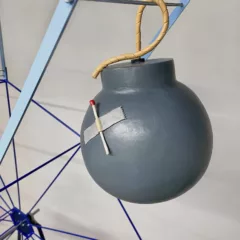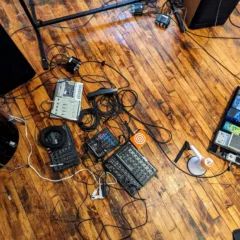[Rachel visits a group show addressing the inescapable fact of art as collaboration and influence. — the Artblog editors]
A bowl of coins labeled “Free Money”.
A massive Connect Four board game.
A book titled “Participation,” filled with blank white pages.
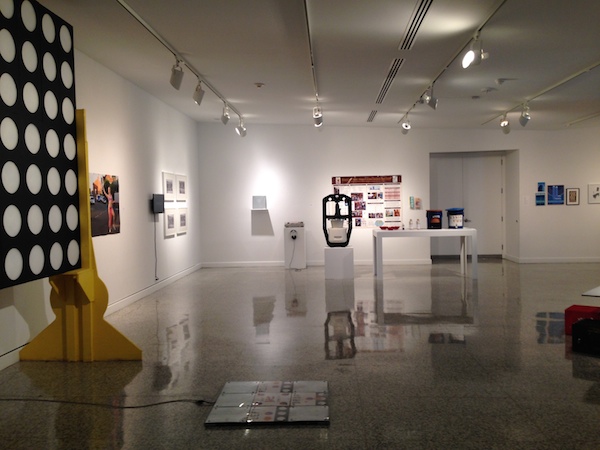
These are only three of the works that comprise Interchange, an exhibition on view at The Galleries at Moore through August 23. Co-organized with members of Grizzly Grizzly and Practice in collaboration with Moore, Interchange stems from the premise that art is always an exchange of ideas. Including local, national, and international artists, the show brings together myriad objects and actions that directly inform our concept of exchange, participation, and response.
Mobile interaction, paused


Detroit-based Trevor Amery presents “Counter History,” a mobile social structure that acts as a coffee stand for “Café Bustelo”–a corrugated aluminum shack complete with coffeemaker, sugar, and disposable cups. Beside the structure, the iconic vacuum-packed coffee is placed on a shelf next to a large-scale map of Miami dotted with pushpins.
The narrative is not explained outright, leaving the viewer connecting the dots between Cuba and South Beach. Amery’s intention, however, was more social than political. Pushing the stand throughout Miami’s streets, the artist stopped at designated points to make coffee for individuals in exchange for personal accounts of the city. Coffee was the incentive, not the critique.
Tongue-in-cheek approaches

Another project rooted in the urban center is “Guerrilla Public Service,” a 2012 work by Los Angeles-based artist Richard Ankrom. Photographs document a man in full construction garb hanging road signs along a Pasadena freeway. Performing legitimacy through costume and props, the worker is really the artist taking his concerns about missing information and its effects on public safety into his own hands. Fabricating the road signs according to state specifications, Ankrom acts as a direct median between governmental obligation and public will.

Other works in Interchange focus on commerce, capitalism, and corporations. In “Lenin for your Library,” artist Yevgeniy Fiks sets out on a donation campaign. After donating Vladimir Lenin’s Imperialism, The Highest Stage of Capitalism to 100 major corporations–including McDonald’s, Amazon, Wendy’s, and The Gap–the artist displays the 34 letters received in return. Nearly all formally rejected Fiks’ donation in subtly crafted prose that will certainly produce a smirk – if not outright laughter.
Digging deeper

Brooklyn-based artist Sal Randolph also engages questions of commerce. In a simple but potent work, Randolph places a white bowl labeled “Free Money” on the gallery floor. Visitors can add, take away, or do nothing–indirectly mimicking society’s daily interactions with cash. The longer one ponders the work, the more the performative exchange becomes both a psychological and sociological consideration.
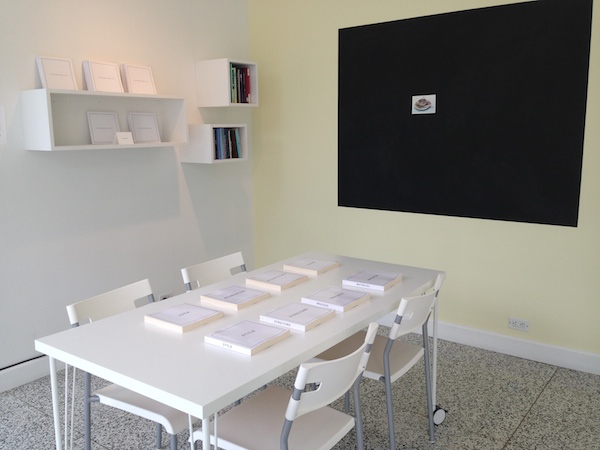
In another project, Randolph presents Library of Art, an eight-volume set of books focused on major principles in contemporary art: Material, Process, Structure, Action, Situation, Duration, Color, and Participation. Viewers are invited to sit and engage, as language itself becomes the central reflection.
Other interpretations
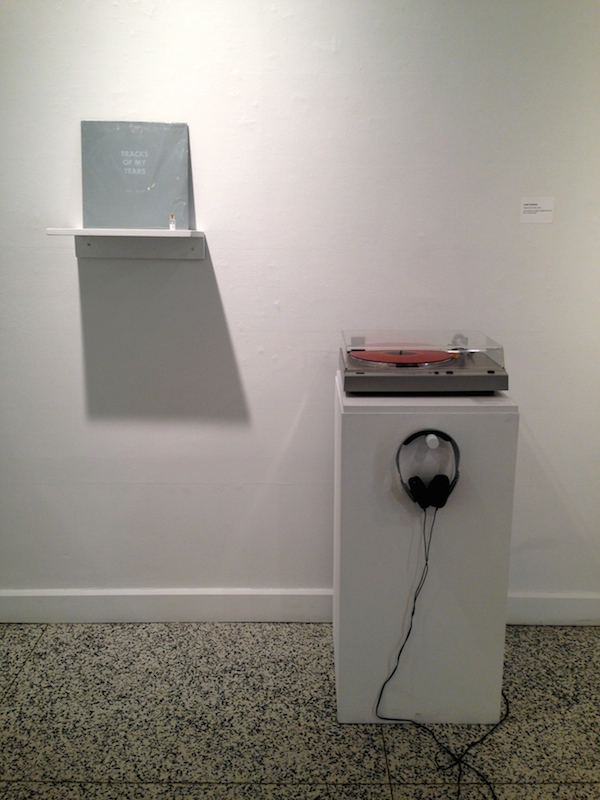
Library of Art is perhaps the most successful project to encompass Interchange’s substantial concept and scope. Nevertheless, other diverse interpretations of exchange are central to the exhibition’s intent. Casey Droege offers a personal understanding in “Tracks of My Tears,” in which she records herself telling stories about the songs that have made her cry; the viewer is invited to listen on a record player that offers its own hefty dose of nostalgia.
Maria Calandra presents an artistic interpretation of exchange by drawing the studios of fellow artists–a project that fits nicely into a long history of artists observing artists. And The Institute for New Feeling invites you to remove your footwear and place a custom-made moleskin adhesive to the bottom of your foot: walking made anew.
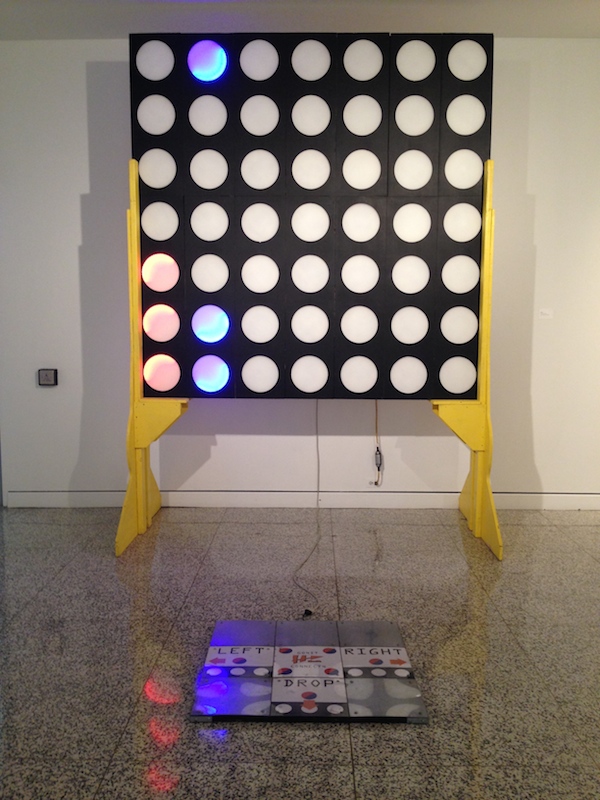
The project that cannot be avoided is Hive76’s “Connect Four”–it’s literally a massive Connect Four board game that is digitally manipulated by the viewer’s movements. (Think Connect Four meets Dance Dance Revolution.) While symbolically perfect and sentimentally playful–and perhaps that is all it is meant to serve–“Connect Four” doesn’t quite live up to its size. It may be a feat of crafty, technical skill, but it ultimately lacks innovation and criticality. Nevertheless, “Connect Four” is far more successful than a handful of works in the exhibition that are too referential or downright banal.
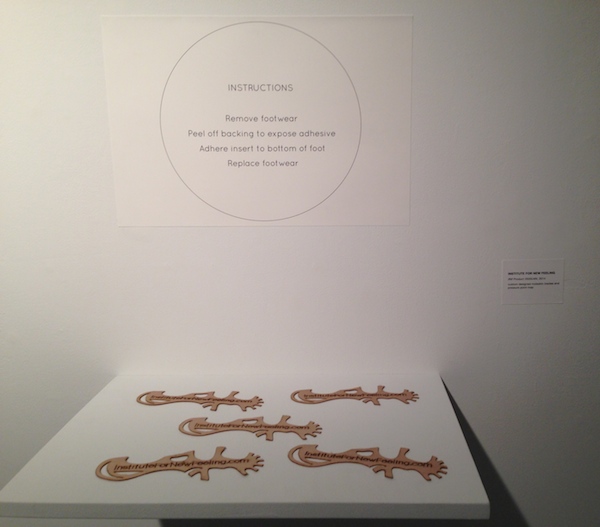
As evidenced by the wide display of projects, Interchange presents a new look at enabling participation within a gallery space. While some works are more successful than others, together the pieces comprise an intelligent body of work that facilitates the inklings of a contemporary understanding of exchange.The show succeeds in bringing together objects and actions focused on reciprocity, interdependence, and communion, and presents these concepts within nuanced discussions such as commerce, environmentalism, and performance.
Though the viewer may leave the show focused on individual works, Interchange produces an overall engaging and clever survey of the process of exchange. It is well worth a visit.
Interchange is on view at the Galleries at Moore through August 23, 2014.




